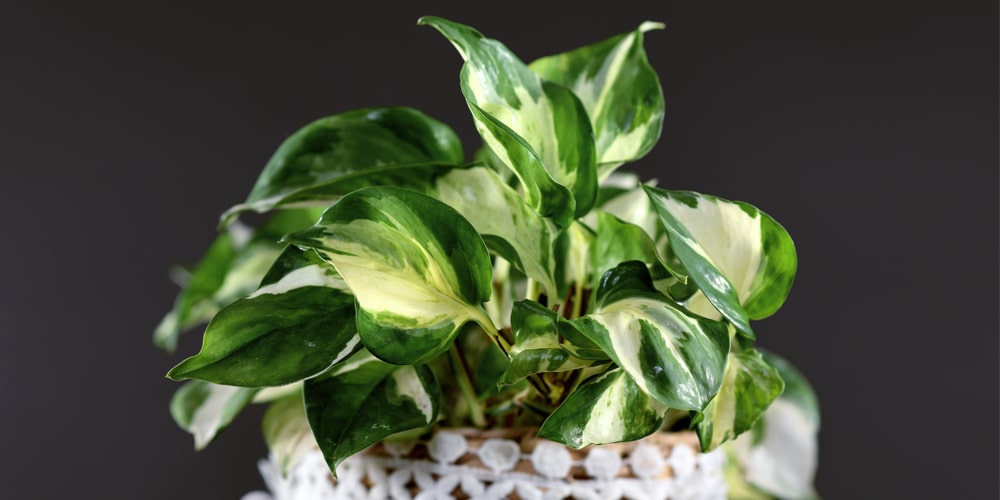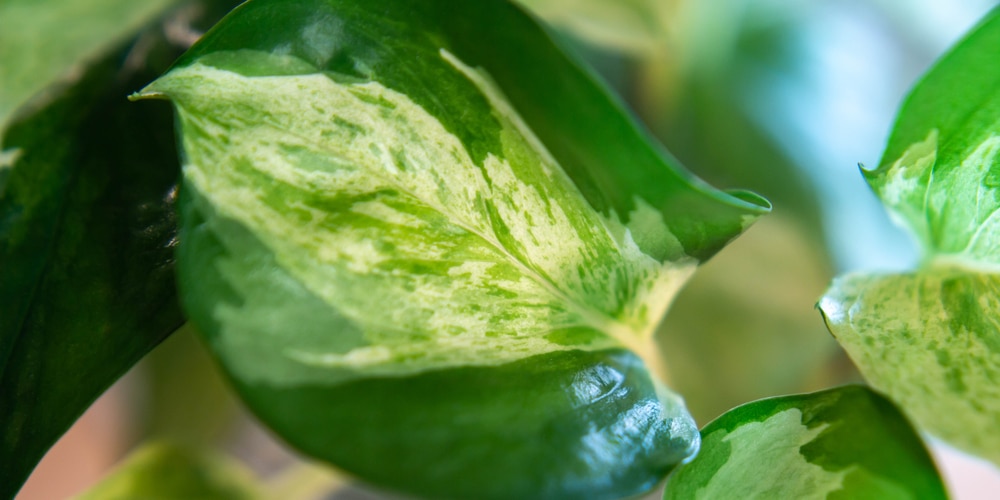Pothos plants are very popular and are commonly grown as house plants throughout the world. The species originates from the Solomon Islands and are members of the Araceae family. Manjula is a popular hybrid variety of Pothos.
Manjula Pothos has the scientific name Epipremnum Aureum and is a hybrid variety grown by the University of Florida. This variety of Pothos looks very similar to the Pearls and Jade Pothos. The main difference between these two plants is that the leaf edges look different. The Manjula Pothos has wavy edges to its leaves.
Manjula Pothos are tropical, evergreen perennials that look great year-round and can be grown in the home or office (here are some other low light office plants). The plant is sometimes called the Happy Leaf plant or Pothos Manjula. Let’s look at how to grow and care for a Manjula Pothos.
What is a Manjula Pothos Plant?

The Manjula Pothos is a slow-growing tropical plant that can get quite large in the right environment. In the right climate, the Manjula Pothos produces vines that can reach up to 40 feet. These plants make great houseplants and can also be grown outdoors in USDA zones 10 to 12.
If you grow a Manjula Pothos indoors in a pot, it will be much smaller, and the size and shape of the plant can be controlled by trimming off vines before they get too long. These plants have beautiful heart-shaped leaves with various hues of green and can also look cream or silver. The foliage has wavy edges and beautiful markings.
These plants grow low to the ground and have dense foliage and trailing vines. The plants bloom in the spring if grown outdoors but are unlikely to flower as a houseplant.
The Manjula Pothos are toxic plants that should be kept out of the reach of young children and pets. If you’re growing the plant outdoors, ensure it won’t be eaten by any livestock, as it’s poisonous to cattle and sheep. Deers and rabbits seem to have a sixth sense and will avoid this plant.
No products found.
Caring for a Manjula Pothos Plant
Manjula Pothos are relatively easy to care for but do have some specific care needs. Providing your plant with the correct lighting, watering, and fertilization will allow your plant to thrive.
Light and Temperature Needs
The Manjula Pothos likes bright indirect sunlight but shouldn’t be left on a hot windowsill, or its leaves may become scorched. The white or cream part of the leaf is particularly sensitive to the sun. When grown in bright sunlight, the plant may survive but stop producing multi-colored leaves and grow only green foliage.
Watering and fertilizer Needs
Manjula Pothos should be grown in soil that’s kept moist but isn’t soggy. These plants don’t like being overwatered and, like most plants, will suffer from root rot if the roots are wet. Don’t overwater your plant or allow it to stand in water.
It’s a wise idea to let the soil dry out almost completely between waterings. Your plant will need to be watered regularly during the growing season and requires less water in the fall and winter. You can give your Manjula Pothos a diluted houseplant fertilizer monthly throughout the growing season.
Soil
Manjula Pothos should be grown in soil that’s light and aerated. These plants like soil that’s loamy and has a neutral pH level of between 6.1 and 6.5. It’s also beneficial to choose a well-draining potting mix. If you want to make your own soil mix, you can use regular houseplant soil and mix in peat moss and perlite.
Pruning and Propagation
When pruning, you can either trim off leaves with a sharp knife or pair of scissors or pinch them off with your fingers. It’s a good idea to cut back the stems regularly as this plant will get quite large otherwise. Pruning also helps to maintain your plant’s shape and can make a pothos thicker and fuller.
You can keep large cuttings and place them in water for propagation. However, it’s worth noting that there are some rules about growing the plant. As Manjula Pothos was developed by the University of Florida and is patented, only licensed growers are allowed to propagate the plant.
Pests
Manjula Pothos can be affected by common houseplant pests such as scale insects, spider mites, and mealybugs. If you notice any insects on your plant, remove them as soon as possible, or infestation will occur. You can wipe your plant’s leaves with a damp cloth to remove insects and eggs. Then use an insecticidal spray to kill any remaining insects. Pay particular attention to the undersides of leaves, as this is where pests are likely to hide.
If you have more than one houseplant, you can quarantine affected plants so that the insects don’t spread. Avoid overcrowding your plants and ensure you provide your plants with the correct care to be more pest resistant.
Disease
Manjula Pothos can suffer from fungal infections, including root rot, botrytis, or leaf spot. These problems are caused by overwatering or excessive humidity and water on the plant’s leaves. The Manjula Pothos doesn’t have a very extensive root system, and overwatering can kill the plant.
You may be able to save an overwatered plant by removing it from the pot, removing as much soil as you can, and cutting off soggy and rotten roots. The plant’s roots can then be treated with a fungicide, and the plant can be repotted using new soil. It’s also wise to use a new pot or soak your pot in a mixture of water and bleach. Ensure the pot is rinsed well before you repot your plant so that it’s not affected by bleach.
Conclusion
Manjula Pothos is a popular tropical houseplant that thrives in areas with low to medium light. These plants can be grown in or outdoors and can climb a trellis. You can also grow the plant in a hanging basket or use it as a tabletop plant. Be careful not to leave your plant on a sunny windowsill, or the leaves may burn.
Last update on 2024-07-26 / Affiliate links / Images from Amazon Product Advertising API
